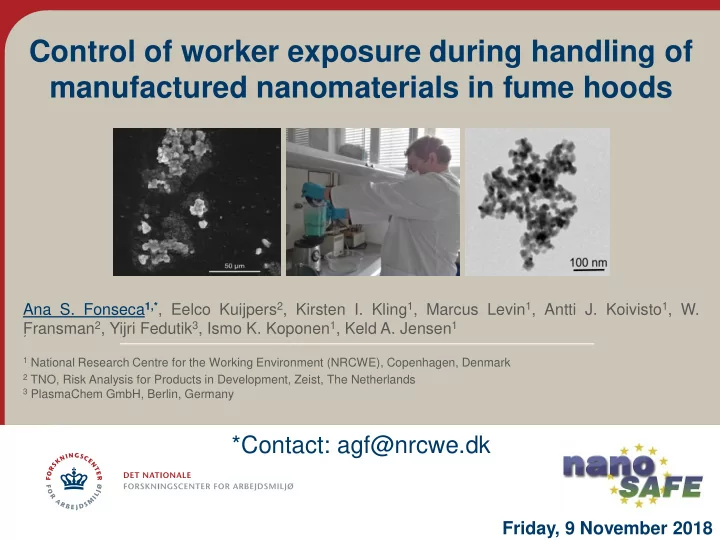

Control of worker exposure during handling of manufactured nanomaterials in fume hoods Ana S. Fonseca 1,* , Eelco Kuijpers 2 , Kirsten I. Kling 1 , Marcus Levin 1 , Antti J. Koivisto 1 , W. Fransman 2 , Yijri Fedutik 3 , Ismo K. Koponen 1 , Keld A. Jensen 1 ´ 1 National Research Centre for the Working Environment (NRCWE), Copenhagen, Denmark 2 TNO, Risk Analysis for Products in Development, Zeist, The Netherlands 3 PlasmaChem GmbH, Berlin, Germany *Contact: agf@nrcwe.dk Friday, 9 November 2018
OUTLINE • Background - Particles impacting human exposure - Adverse health effects • Motivation and relevance • Particle release and control of worker exposure - Objectives - Exposure assessment strategy - Real case scenario: synthesis and handling of manufactured nanomaterials in fume hoods - Simulated spills of manufactured nanomaterials in fume hoods • Conclusions and recommendations
BACKGROUND Particles impacting human exposure Bacteria Antibody Virus Pollen Size range of primary nano-objects ≤ 100 nm PN (cm -3 ) PM (µg m -3 ) µm Fine particles Coarse particles (< 2.5 μm ) (> 2.5 μm ) Nanoparticles (NP) ≤ 100 nm 60 - 80 % 50% in the workplace indoors (Klepeis et al. , 2001)
BACKGROUND Particles impacting human exposure Size range of primary nano-objects ≤ 100 nm (COM, 2011; ISO, 2015) PN (cm -3 ) µm NP from thermal NP from mechanical Soot particle TiO 2 CNT processes processes Engineered Non-engineered 4 nanoparticles nanoparticles (ENP) (N-ENP) 100 nm
BACKGROUND Particles impacting human exposure Occupational settings New risks and uncertainties! dealing with ENP NP from thermal NP from mechanical Soot particle TiO 2 CNT processes processes Engineered Non-engineered 5 nanoparticles nanoparticles (ENP) (N-ENP) 100 nm
BACKGROUND Adverse health effects Higher potential for adverse Main exposure route health effects Fractional deposition of inhaled particles in the human respiratory tract. Source: Koivisto (2013) Ability to penetrate Translocate to the blood Transported directly to deeper in human lungs circulatory system the brain Major current ENP emerging risks at (<100 nm) workplaces!
MOTIVATION AND RELEVANCE Control of worker exposure Synthesis and handling of ENPs are common tasks in nanotechnology research Fume hoods have been used to protect workers from exposure to airborne ENPs Significant release of ENPs into the workplace air (>1 x 10 4 cm -3 ) have been detected while manufacturing and handling nanopowders (Tsai et al. 2009) Fonseca et al . (2018) J Nanopart Res., 20:48
OBJECTIVES ASSESSMENT OF PARTICLE RELEASE AND WORKERS ’ INHALATION EXPOSURE DURING SYNTHESIS AND HANDLING UNDER A FUME HOOD CuO TiO 2 ZnO EVALUATION OF THE CAPACITY OF A FUME HOOD TO PREVENT PARTICLE RELEASE DURING SIMULATED SPILLAGE Drop height Material Mass load TiO 2 , SiO 2 , and 5-40 cm 5-125 g zirconia TZ-3Y Fonseca et al . (2018) J Nanopart Res., 20:48
EXPOSURE ASSESSMENT STRATEGY (Organization for Economic Co-operation and Development; OECD, 2015) Approach: simultaneous measurements in emission (near field; NF), background location (far field; FF) and in breathing zone (BZ) V=133.6 m 3 Source: modified from OECD (2015)
REAL CASE SCENARIO Synthesis and handling CuO under a fume hood • CuO (CAS No.1317-38-0) CuO average exposure level = 9.2 μg m -3 • Primary size 40 ± 10 nm Ratio NF/FF= 2.8 NM exposure may occur if the fume- hood is not working properly!
REAL CASE SCENARIO Synthesis and handling CuO under a fume hood • CuO (CAS No.1317-38-0) CuO average exposure level = 9.2 μg m -3 • Primary size 40 ± 10 nm Ratio NF/FF= 2.8 NM exposure may occur if the fume- hood is not working properly!
SIMULATED SPILLS Drop height Material Mass load TiO 2 , SiO 2 , and 5-40 cm 5-125 g zirconia TZ-3Y
SIMULATED SPILLS Example: 60 g TiO 2 (rutile) from 40 cm drop height Notable increase in particle concentrations were rarely detected in the breathing zone of the worker
SIMULATED SPILLS
SIMULATED SPILLS
SIMULATED SPILLS Powder spills were sometimes observed to eject into the laboratory room and contaminate the workers’ laboratory clothing but rarely associated with significant particle release from the fume-hood to the worker’s BZ Fume-hood protection factors mean efficacy of 98.3% 𝜁 (%) = 1 − 𝑂 𝑇𝑞𝑗𝑚𝑚,𝐶𝑎 − 𝑂 𝐶𝐻,𝐶𝑎 (total range from 78 to 99%) × 100 𝑂 𝑇𝑞𝑗𝑚𝑚,𝑂𝐺 − 𝑂 𝐶𝐻,𝑂𝐺 Suggests that fume-hood effectiveness is independent of the type of NM
CONCLUSIONS • This study confirms that an appropriate fume-hood prevents well against particle release into the general laboratory environment. The average in-use protection efficacy was 98.3% RECOMMENDATIONS: Safe approaches for cleaning powder spills should be prepared to prevent exposure via resuspension and inadvertent exposure by secondary routes. A regularly fume- hood’s operational status checking is recommended.
THANK YOU VERY MUCH FOR YOUR ATTENTION! Ana Sofia Fonseca Contact: agf@nrcwe.dk Acknowledgements: This work is part of the caLIBRAte Project funded by the European Union's Horizon 2020 research and innovation programme under grant agreement No 686239
Recommend
More recommend